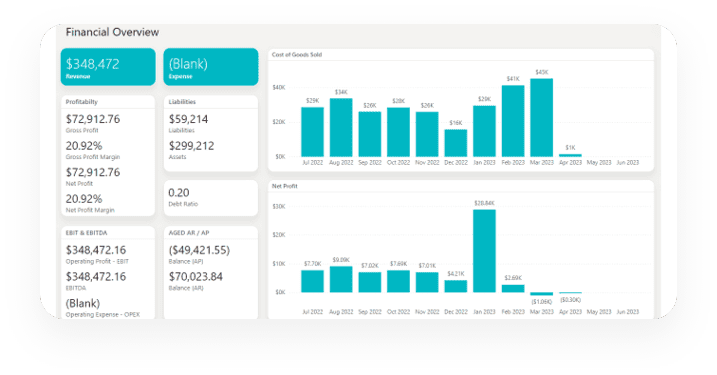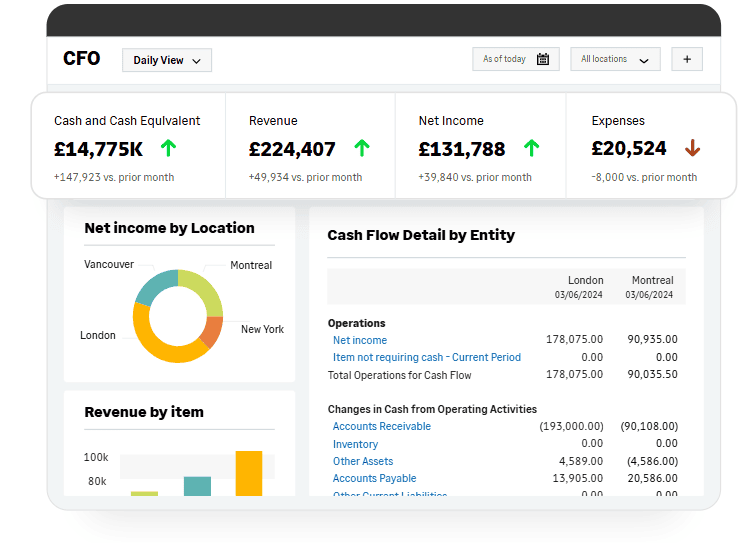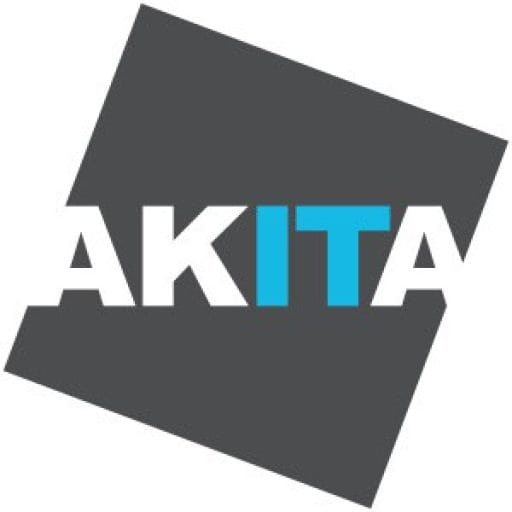Finance platforms are integral to business operations, holding the potential to transform how businesses manage their operations. Modern cloud platform real-time access to financial data, seamless collaboration, and improved decision-making capabilities.
Sage has been one of the main contenders in this arena for many years, with Sage Intacct its central cloud offering for finance.
In recent years though, Microsoft has been driving into this space with its Dynamics 365 Business Central application. As many organisations operate on Microsoft software for their wider operations, there’s enough of a case to investigate its capabilities as a robust finances management solution.
Below we compare Business Central vs Sage Intacct, highlighting their strengths, limitations, and suitability for different organisational needs
Overview of Microsoft Dynamics 365 Business Central
Microsoft Dynamics 365 Business Central is a comprehensive business management solution designed for small to medium-sized enterprises (SMEs). It integrates various business processes – including finance, sales, service, and operations – into a single, unified cloud platform.
As part of the Microsoft ecosystem, Business Central offers seamless integration with other Microsoft products such as Office 365, Power Platform, and Teams, enhancing productivity and collaboration.
Features of Business Central include:
- Financial Management: Robust accounting capabilities, including general ledger, accounts payable and receivable, budgeting, and cash flow management.
- Supply Chain Management: Business Central offers functionality for inventory control, purchasing, and vendor management to optimise supply chain operations.
- Sales and Service Management: The platform includes customer relationship management (CRM) functionalities to manage sales processes and service engagements.
- Project Management: Features for planning, resource allocation, and tracking project progress and costs.
- Manufacturing: Capabilities for production planning, scheduling, and management of manufacturing processes.
Overview of Sage Intacct
Intacct is Sage’s cloud-based financial management solution similarly tailored primarily for SMBs.
Intacct focuses on delivering deep accounting functionalities and real-time financial insights to support informed decision-making. Sage Intacct is known for its strong financial capabilities and scalability
Sage Intacct is known for its strong core financial capabilities, including accounts payable and receivable, general ledger, and cash management. Wider features include:
- Order Management: Automation of order processing to improve accuracy and efficiency.
- Purchasing: Streamlined procurement processes with approval workflows and vendor management.
- Dashboards and Reporting: Customizable dashboards and financial reports for real-time visibility into business performance.
- Multi-Entity Management: Capabilities to manage multiple entities or locations with ease.
Business Central vs. Sage Intacct: How Do They Compare?
Functionality and Scope
- Business Central: Offers a wide range of functionalities beyond core accounting, including supply chain, manufacturing, project management, and CRM. But it’s no slouch in the finance department either (see more features here). This makes it a comprehensive ERP solution suitable for businesses seeking an all-in-one platform.
- Sage Intacct: The platform primarily focuses on financial management and accounting. While it excels in these areas, it requires additional integrations for wider functionalities like CRM or manufacturing.
Integration and Ecosystem
- Business Central: Seamlessly integrates with other Microsoft products, providing a cohesive experience for users familiar with the Microsoft ecosystem. This integration enhances productivity and simplifies user adoption.
- Sage Intacct: Offers integration capabilities through APIs and partnerships with third-party applications. However, the integration experience may not be as seamless as with Business Central, especially for organizations heavily invested in Microsoft products.
Customisation and Flexibility
- Business Central: A huge benefit of Business Central is how it can be tailored to different workflows. It can also be configured to deliver a wide range of reports to meet specific finance and business needs. It also supports extensions and add-ons to enhance functionality.
- Sage Intacct: Provides customisation options, particularly in financial reporting and dashboards. However, customisation beyond financials is much more limited compared to Business Central.
Scalability and Growth Potential
- Business Central: Built to scale with businesses, Business Central supports growing organisations with increasingly complex needs. Its modular functionality means businesses can adopt only the features they need initially and expand functionality as they grow. With advanced features like manufacturing, supply chain management, and CRM functionality, it provides a long-term solution for scaling operations.
- Sage Intacct: Primarily focused on financial management, Sage Intacct offers scalability within its niche. While it supports multi-entity organisations and can handle growing financial complexities, businesses may require additional tools or integrations for non-financial needs as they expand, potentially complicating growth.
Cost and Pricing Structure
- Business Central: Operates on a tiered subscription model, allowing organisations to pay for what they use. Costs are flexible based on user numbers and required functionality. Given its comprehensive feature set, Business Central provides strong value for organisations seeking an all-in-one ERP system.
- Sage Intacct: Pricing is subscription-based and largely determined by the size of the business and the complexity of financial operations. While it may be more cost-effective for smaller businesses focused solely on financial management, the need for additional tools to cover broader business functions could increase the total cost of ownership.
Implementation and Support
- Business Central: As part of the Microsoft ecosystem, implementation is supported by a global network of partners, including Akita. Businesses benefit from expert guidance during setup and ongoing support, ensuring seamless operation. Its familiar interface and extensive documentation reduce the time required for user adoption.
- Sage Intacct: Implementation is often handled by certified Sage partners. While it is typically straightforward for financial management, integrating it with additional third-party tools can add complexity, particularly for organisations with diverse operational needs. Akita is able to provide ongoing support Sage as a platform but this can require assistance from Sage.
Business Central vs Sage Intacct: Which is right for your operations?
When comparing Business Central vs Sage Intacct, the right choice depends on your organisation’s needs. If your focus is purely on financial management, Sage Intacct provides a robust solution.
However, for businesses looking for more than just a financial management tool, Microsoft Dynamics 365 Business Central offers a more comprehensive solution for businesses seeking to manage all operations on a single platform. Its deep integration with the Microsoft ecosystem is also a significant plus.
At Akita, we have specialist that implement Business Central for organisations of all sizes, ensuring smooth transition and maximising the platform’s benefits.
If you’re considering an ERP system to support your business, we’d be delighted to discuss how Business Central can drive your success. Get in touch today to learn more:
Contact Us





